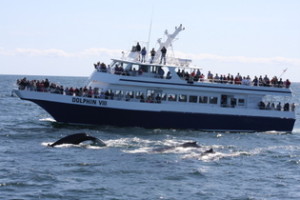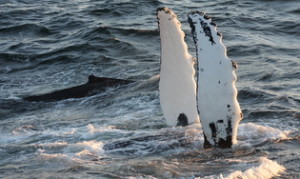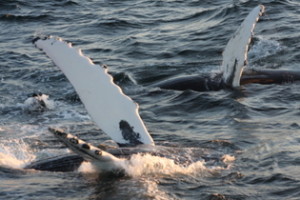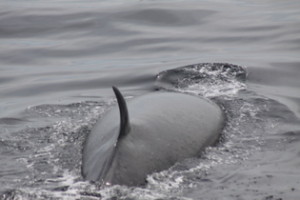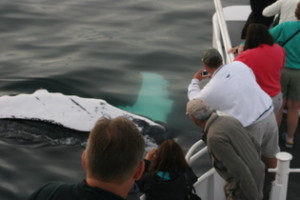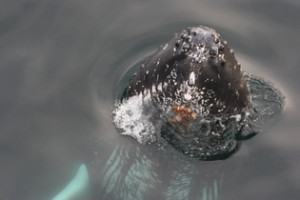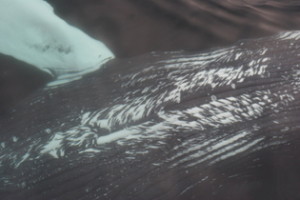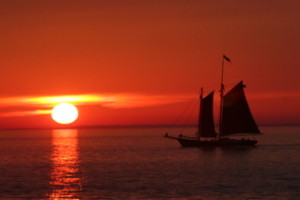Dolphin Fleet Naturalist Notebook 5 September to 12 September
On September 5th we began the day by heading out to the Triangle, an area just east of Stellwagen Bank. In less than an hour into the trip, we encountered Tulip and her calf. Tulip is a humpback named for the Tulip-shaped marking on her right fluke. Today, we watched as her calf, who is between 6 and 8 months old, swam back and forth beneath its mother, which is a behavior suggestive of nursing. A calf will feed on its mother’s milk for almost the first year of its life. Just like with many mammals (including humans), the amount of time that a calf stays with its mother may vary. Some calves may go off on their own only nine months into their lives, while others may stay with their mothers for over a year, remaining with them as they migrate southward, then back up north to the feeding grounds for a second season. Feeding on their mother’s milk, which is about 40% milkfat, they may gain up to 100 pounds a day!
Adults on the other hand, have to locate their own food, usually in the form of small schooling fish. Although humpback feeding may occur at any time of day, their prey might inhabit different depths in the water column throughout a diel period. This is why it was not surprising to see what we assumed was bottom feeding during the morning and surface lunge feeding in the afternoon. Although this pattern is not necessarily the norm, it does show how food distribution can change even over the course of a few hours!
September 6th was another bright and sunny day, although the winds had picked up considerably. Although each trip of the day had sightings of between 6 and 22 humpback whales, the highlight of the day occurred on one of the sunset trips aboard the Dolphin VI. First, while watching Tulip and her calf head towards the Triangle, we spotted a humpback whale breaching less than a quarter of a mile away!
As we headed further to the east, another humpback named Tracer also leapt out of the water. We don’t know why a 40 ton animal would choose to take time out of foraging for food in order to launch itself out of the water, so it can be hard to predict when it will occur, but Tracer’s huge breach seemed to be mimiced by another animal in the same area.
We spent the last portion of our trip with a humpback named Reflection and her calf. As we approached, Reflection rolled over and began to slap her enormous, white flipper on the water. The pectoral flippers of an adult humpback are approximately 15 feet long, and some scientists suggest that this flipper-behavior may have something to do with intraspecific (within-species) communication, and may even have something to do with group formation.
Soon after Reflection began this display, her calf rolled over and did the same. Perhaps Reflection was communicating with conspecifics and the calf was just copy-catting, or perhaps Reflection was teaching her calf the ins and outs of humpback whale behavior. It is hard to know for sure. In either case, as this humpback calf will be venturing off on its own soon, it will need to use these behaviors for the rest of its life.
Reflection flipper slaps
The calf joins in
On September 7th, amongst many humpbacks, several fin whales, and even a few minkes, we had two very notable sightings. The first occurred in the afternoon aboard the Portuguese Princess II. One of our naturalists, John Conlon, offers an account of the sighting:
On the morning trip of Monday, September 7th, Capt. Todd Motta made the first tentative ID of a sei whale based primarily on the first (and good) look at the animal’s tall and arced dorsal fin. The next two surfacings were at difficult distances and bad angles of sight. The animal had to surface several more times before I was able to get my first good look at it some 200 yards from the Portuguese Princess II. The whale allowed a great, though still somewhat distant look. On that fourth sighting the animal lay profile to the boat at some 200 yards in the distance. The identification as a sei whale was then quick and straight forward. It lay quite level in the water with its blowholes and dorsal fin simultaneously visible at the surface. This somewhat typical surfacing position, allowing the blowholes and dorsal fin to be seen simultaneously, would not be expected from a fin whale which is the only other balaenopterid whale seen locally that is likely to be confused with a sei whale.
Upon closer examination its left to right coloration was symmetric as opposed to the asymmetric left to right coloration of a fin whale. Having said this the sei whale does have similar blaze and chevron streaking to that of a fin whale. This streaking is more a blue-gray than the gray-white of a fin whale. This streaking is more evenly patterned on both sides of the sei whale. In my experience the streaking has been more difficult to see. This though is likely due to the gray and or overcast light conditions that accompanied most of my sei whale sightings.
Sei whale breathing / movement sequences are also used by field workers to distinguish sei whales from other balaenopterids. Two or three rather diffuse spouts were followed by several minute duration dives. This is fewer breaths and shorter dive times than would be expected from a fin whale. This animal’s motion through the water was also quite erratic. Its motion was regularly back and forth through a small area. This would generally be interpreted as subsurface fin whale feeding behavior. In the case of sei whales, however, they are often reported as moving in these erratic patterns when searching as well as feeding. It was thus not possible to make the searching or feeding determination. The behavior combination of diffuse spout, respiration sequences, and erratic movement makes sei whales very difficult to observe.
While sei whales tend to stay farther offshore toward the edge of the continental shelf it is not surprising that we had this opportunity. Over the past two weeks we have had several days where we observed whales and pelagic birds feeding on large surface concentrations of krill. Sei whales are well known as a balaenopterid whale capable of skim feeding on planktonic copepods and krill.
In our sighting area sei whales are rarely and unpredictably seen as singles, pairs or triplets. They are, however, known to arrive in larger groups and stay within the area for short periods of time. They then disappear not to be seen as individuals or groups potentially for many years. Over the years my experiences with sei whales have been a single, a pair, and a triplet. On an evening trip some five years ago we observed some 20 sei whales skim feeding in the company of northern right whales. In all these cases my sightings were one time only regardless of the number of individuals or their activity. In all cases the animals moved on to areas presumably beyond our whale watch reach…
A sei whale breaks the surface
Later, while watching a pod of Atlantic white-sided dolphins, we noticed that one particular individual had an orange tag affixed to its dorsal fin. We took careful pictures and contacted IFAW’s Marine Mammal Rescue Team to see if they could tell us this particular dolphin’s story.
Tagged dolphin
According to Sarah Sharp of the rescue team, “she was a 175 cm sub-adult female who stranded with two other animals on September 1st in Wellfleet. She was found near Tavern Point on Great Island, while the two other dolphins were refloated by an incoming tide and swam off, she remained grounded. Our health assessment determined her to be in good health, and we towed her alongside the Wellfleet harbormaster’s vessel out past Jeremy Point and released her into Cape Cod Bay at approximately 11:30am on that day. She was initially spotted by WCNE the following day with a group of 50-60 Atlantic-white sided dolphins off the west side of Stellwagen.”
For more information on IFAW’s Marine Mammal Rescue Team, check out their blog at: http://animalrescue.typepad.com/
On September 8th we had another exciting sunset trip, starting with a humpback whale, who, like Reflection and her calf earlier in the week, was lying on its back, flipper-slapping. After sticking with this whale for about ten minutes, we decided to check out who else was in the area. This proved to be an excellent decision. As we steamed to the north we came across another pair of humpbacks, who almost immediately approached the boat.
As these two humpbacks rolled alongside the Dolphin VIII, they remained in very close contact with one another. As much as they were interacting with each other, they were also curious about the boat, with one animal even peeking its head out of the water to get a closer look.
At one point, one of them even rolled over enough so that we could see its entire belly. Humpbacks belong to a group of baleen whales known as the “rorquals.” Rorqual whales are characterized by the flexible pleats lining the ventral side of their body. When these whales engulf mouthfuls of food and water, these pleats stretch out stretch out like a baloon, and then contract, to push out the salt water and retain the prey.
A humpback displays its ventral pleats
By September 9th, the wind had picked up considerably, but we were still able to make our way to humpbacks and Minke whales north of Race Point. Minke whales often receive less attention aboard whale watch boats because they don’t remain at the surface for very long. Often, when passengers see the triangular dorsal fin of a Minke whale quickly break the surface, they think that they are looking at a porpoise or dolphin. This is why many are surprised to learn that Minke whales can often grow to exceed 25 feet in length! It is amazing that the vast size of the ocean can make something look so small! Despite their brief appearances, Minkes are common to the area, and a careful observer will almost always be able to spot at least one or two during a trip north of Cape Cod.
Sadly, the whale watches from September 10-12 were cancelled due to rain and high winds, but we are looking forward to clearer skies and calm seas next week!






